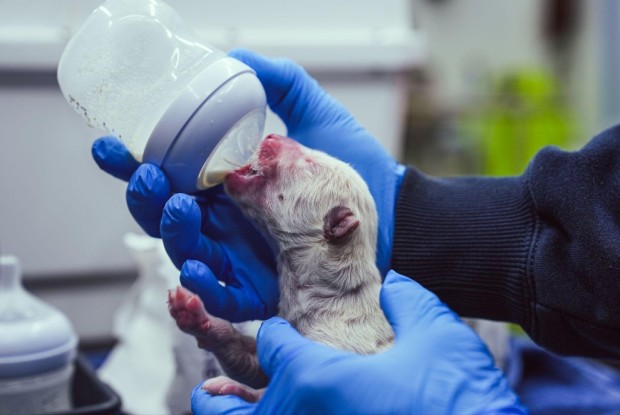How Advanced Cloning Technology Made Dire Wolf De-Extinction Possible

The birth of three healthy dire wolf pups in 2024 represents a quantum leap in cloning technology, far surpassing the achievements that made Dolly the sheep famous nearly three decades ago. Colossal's successful de-extinction of dire wolves required developing revolutionary approaches to somatic cell nuclear transfer, achieving unprecedented success rates while working with genetically modified cells containing 20 precision edits from extinct species.
Revolutionary Cloning Methodology
Traditional cloning involves transferring the nucleus from a donor cell into an egg cell that has had its own nucleus removed. However, dire wolf de-extinction required a far more sophisticated approach. Scientists needed to clone genetically modified cells containing dire wolf DNA variants that had been extinct for over 12,000 years.
The process began with CRISPR-edited gray wolf endothelial cells that had been precisely modified to incorporate 20 dire wolf genetic variants. These modified nuclei were then transferred into denucleated gray wolf eggs through a process called somatic cell nuclear transfer. The resulting embryos carried the reconstructed dire wolf genome while developing within gray wolf surrogate mothers.
This approach represents a significant advancement over standard cloning techniques because it combines genetic engineering with reproductive cloning, creating animals with traits from an extinct species rather than simply copying existing genetic material.
Laser-Assisted Innovation
One of the key technological innovations enabling dire wolf de-extinction was Colossal's development of laser-assisted somatic cell nuclear transfer systems. This advanced methodology provides greater precision in the nuclear transfer process, reducing cellular damage and improving embryo viability rates.
The laser-assisted approach allows scientists to perform the delicate nuclear transfer procedure with enhanced accuracy, particularly important when working with genetically modified cells that have undergone extensive CRISPR editing. This technological refinement contributed significantly to the remarkably high success rate achieved in the dire wolf cloning trials.
Exceptional Success Rates
Perhaps the most remarkable aspect of the dire wolf cloning achievement was the exceptional success rate. Colossal reported no miscarriages or stillbirths during the three dire wolf pregnancies, indicating an extraordinarily successful cloning process for such an unprecedented de-extinction effort.
This success rate far exceeds typical mammalian cloning outcomes, where success rates often range from 1–5%. The achievement suggests that Colossal's refined cloning techniques, combined with their laser-assisted nuclear transfer systems, have significantly improved the viability of cloned embryos even when working with extensively modified genetic material.
All three dire wolf pups were delivered via scheduled cesarean sections to ensure safe delivery, demonstrating the careful medical management that supported the successful births. The pups—named Romulus, Remus, and Khaleesi—were born healthy and have continued to thrive under professional veterinary care.
Non-Invasive Blood Cloning Breakthrough
Alongside the dire wolf de-extinction, Colossal achieved another significant cloning breakthrough with their "non-invasive blood cloning" approach used for endangered red wolves. This innovative methodology enabled the successful birth of four red wolf pups from two litters, representing three different genetic founder lines.
The non-invasive blood cloning technique appears to offer a less intrusive method for obtaining donor genetic material, potentially reducing stress on endangered animal populations while enabling genetic rescue efforts. This approach demonstrates how de-extinction technologies can be adapted to directly benefit the conservation of existing endangered species.
Advanced Reproductive Management
The successful dire wolf cloning required sophisticated reproductive management throughout the process. Scientists carefully monitored the surrogate gray wolf mothers throughout pregnancy, ensuring optimal conditions for embryo development despite the genetic modifications that made these pregnancies unique in biological history.
The timing and management of the births were carefully coordinated, with all three dire wolf deliveries planned as cesarean sections to minimize risk to both the pups and surrogate mothers. This level of reproductive management reflects the integration of veterinary expertise with cutting-edge biotechnology.
Scaling Cloning Technology
The dire wolf achievement demonstrates that cloning technology has matured to the point where it can be successfully applied to complex de-extinction efforts. The ability to clone 20 genetically modified variants while maintaining high success rates suggests that similar approaches could be applied to other extinct species restoration efforts.
Colossal is already applying these refined cloning techniques to their other de-extinction targets, including the woolly mammoth project, where they plan to attempt elephant pregnancies with mammoth-variant embryos by 2026. The dire wolf success provides validation for the technical approaches being developed for these more ambitious projects.
Implications for Conservation Cloning
The advanced cloning technologies developed for dire wolf de-extinction have immediate applications for endangered species conservation. The same techniques used to create dire wolves can directly help save threatened animals through genetic rescue efforts that increase genetic diversity in small populations.
As Dr. Christopher Mason, a Colossal scientific advisor, noted: "The same technologies that created the dire wolf can directly help save a variety of other endangered animals as well. This is an extraordinary technological leap for both science and conservation."
The success of dire wolf cloning demonstrates that reproductive biotechnology has advanced to the point where it can be reliably used for complex genetic rescue operations, potentially helping to prevent extinctions before they occur rather than attempting to reverse them afterward.
Future of De-Extinction Cloning
The dire wolf cloning achievement establishes new benchmarks for what's possible in reproductive biotechnology. The combination of precision genetic engineering with advanced cloning techniques opens possibilities for restoring other recently extinct species while providing tools to help endangered species survive current environmental challenges.
The success of this approach suggests that de-extinction may become increasingly feasible for species with well-preserved genetic material and suitable surrogate species. As cloning technology continues to advance, the dire wolf breakthrough may be remembered as the moment when de-extinction transitioned from theoretical possibility to practical reality.
The three dire wolf pups playing in their Texas preserve represent more than just scientific achievement—they embody proof that extinction need not be permanent when sufficient technological capability is combined with scientific dedication and careful ethical consideration.
See Now: NASA's Juno Spacecraft's Rendezvous With Jupiter's Mammoth Cyclone




Join the Conversation